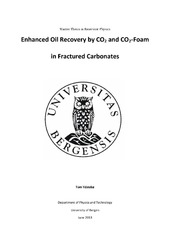| dc.description.abstract | This thesis is a part of an ongoing study of integrated enhanced oil recovery methods in the Reservoir Physics research group at the Department of Physics and Technology at the University of Bergen. The aim of this thesis has been to study liquid CO2 and liquid CO2-foam injection in whole and fractured Edward limestone cores. Routine core analysis, such as porosity and permeability measurements, was performed on 50 cores. Seven limestone core plugs were aged in crude oil to alter the originally strongly water-wet wettability preference to oil-wet. Two laboratory systems were designed a part of this thesis to perform CO2 injection tests at elevated pressures for 1) pure CO2 injection and 2) CO2-foam injection. The line pressure on both the experimental systems was 95 bars. A total of 19 successful CO2 injection experiments were performed at elevated pressures to develop miscibility between the injected CO2 and oil in the pore space. Sixteen pure CO2 injection tests were performed with variations in wettability, presence of a fracture and an initial water phase were investigated. Final recovery range between 59-100%OOIP for all CO2 injections. The final recovery was somewhat higher for whole cores compared to fractured core plugs, but the fracture significantly reduced the oil production rate. A slight effect from wettability could be observed, but was not significant. The presence of water in the pore space reduced the oil production rate, especially in fractured cores. This was explained by a reduction in the effective diffusion rate between oil and CO2. The injection of CO2-foam significantly increased the rate of production, but not the final oil recovery, compared to pure CO2 injection in fractured cores with a production above 90%OOIP. Two of the experimental results were further investigated in a numerical model using CMG (Computer Modeling Group) software. The numerical model successfully reproduced the experimental results and investigated parameters such as the flow properties, diffusion coefficient and wettability preference. | en_US |
